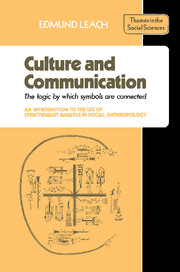 Culture and Communication
Culture and Communication Book contents
- Frontmatter
- Contents
- Culture and communication: the logic by which symbols are connected
- Introduction
- 1 Empiricists and rationalists: economic transactions and acts of communication
- 2 Problems of terminology
- 3 Objects, sense-images, concepts
- 4 Signals and indices
- 5 Transformations
- 6 Theories of magic and sorcery
- 7 The symbolic ordering of a man-made world: boundaries of social space and time
- 8 The material representation of abstract ideas: ritual condensation
- 9 Orchestral performance as a metaphor for ritual sequence
- 10 The physiological basis of sign/symbol sets
- 11 Mapping: time and space as reciprocal representations
- 12 Rank order and orientation
- 13 Examples of binary coding
- 14 Mating prescriptions and proscriptions
- 15 Logic and mytho-logic
- 16 Basic cosmology
- 17 Rites of transition (rites de passage)
- 18 The logic of sacrifice
- 19 Conclusion
- Bibliography
- Index
10 - The physiological basis of sign/symbol sets
Published online by Cambridge University Press: 05 June 2012
- Frontmatter
- Contents
- Culture and communication: the logic by which symbols are connected
- Introduction
- 1 Empiricists and rationalists: economic transactions and acts of communication
- 2 Problems of terminology
- 3 Objects, sense-images, concepts
- 4 Signals and indices
- 5 Transformations
- 6 Theories of magic and sorcery
- 7 The symbolic ordering of a man-made world: boundaries of social space and time
- 8 The material representation of abstract ideas: ritual condensation
- 9 Orchestral performance as a metaphor for ritual sequence
- 10 The physiological basis of sign/symbol sets
- 11 Mapping: time and space as reciprocal representations
- 12 Rank order and orientation
- 13 Examples of binary coding
- 14 Mating prescriptions and proscriptions
- 15 Logic and mytho-logic
- 16 Basic cosmology
- 17 Rites of transition (rites de passage)
- 18 The logic of sacrifice
- 19 Conclusion
- Bibliography
- Index
Summary
I have just remarked that ‘signs and signals both masquerade as signals’. I gave an example in Section 4 when referring to Pavlov's dog, but I now want to take the point rather further.
Since signals are part of our animal nature they are clearly the most basic components in our communication system. Cultural devices, however complex, must always be built on biological foundations. But although some of the signalling mechanisms manifested in physical reactions of the human body are fairly obvious, there is considerable controversy about others, and about where ‘instinct’ ends and ‘culture’ begins.
Smiling, weeping, laughing are universally part of the inventory of infant behaviour. Kissing seems to be a modification of suckling. Penile erection is a male adult reaction to erotic stimulus of various kinds. Eye and eyelid movements signal recognition. Anger, fear, shame are descriptions of ‘emotions’ which are a psychological reflex of physical reactions which are probably common to the whole species.
In appropriate circumstances nearly all such automatic reactions may be used to convey culturally recognised messages. For example, in English convention weeping ‘means’ sorrow, laughter ‘means’ joy, a kiss ‘means’ love. But these conscious associations are not human universals and sometimes the symbol/sign meaning of an action can be completely divorced from the signal response to which it refers.
For example, formalised weeping very frequently forms part of the correct behaviour of mourners at a funeral. But the official mourners are not necessarily the individuals whom one might expect to be emotionally affected.
- Type
- Chapter
- Information
- Culture and CommunicationThe Logic by which Symbols Are Connected. An Introduction to the Use of Structuralist Analysis in Social Anthropology, pp. 47 - 50Publisher: Cambridge University PressPrint publication year: 1976


